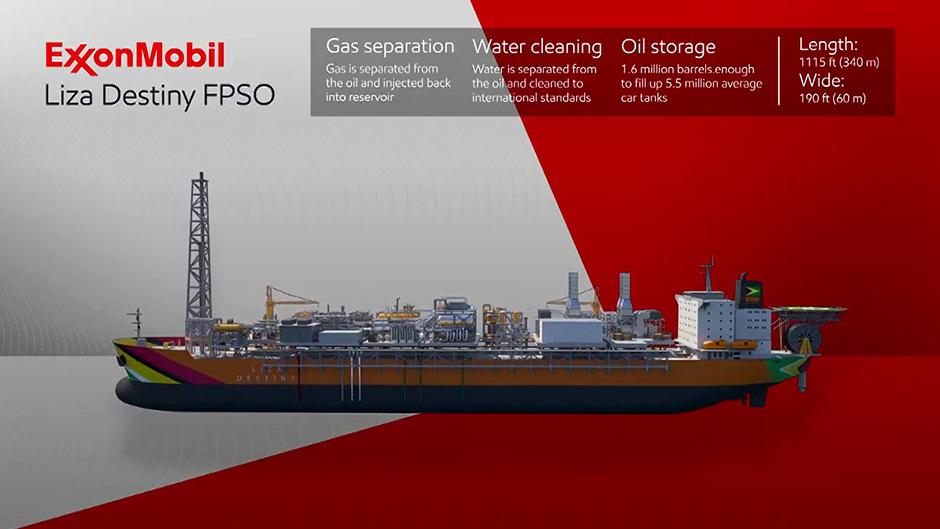After announcing only last month that it had rectified problems on the Liza Destiny Floating Production Storage and Offloading (FPSO) vessel which saw the company flaring over two billion cubic feet of associated gas in 2020, ExxonMobil yesterday said that it has begun flaring again after experiencing another issue with its compressor seal.
While Exxon made the revelation, there was no word from Guyana’s Environmental Protection Agency (EPA) but its former Head, Dr Vincent Adams roasted the company for its continued lapses.
“There was a technical issue regarding a seal on the gas compressor on Liza Destiny. This unfortunate incident resulted in us having to temporarily increase our flare above pilot levels in order to maintain safe operations”, Exxon said yesterday in a terse statement.

Alistair Routledge, President of ExxonMobil Guyana, was quoted as saying “We are disappointed that this unexpected issue has occurred and we’re working diligently with the vessel’s owner and the equipment vendor to understand and fix the issue as quickly as possible.”
From the beginning of production in December of 2019, ExxonMobil had been beset by technical problems in meeting its target of 120,000 barrels of oil per day (bpd) which saw large volumes of gas being flared.
The large amounts flared from its offshore operations prompted the EPA under Adams to put the company under close scrutiny and had production rates reduced to, at one time, 30,000 bpd and flaring between 12 million to 15 million cubic feet per day.
The World Wildlife Fund, as well as a global environmental and human rights organisation, the Center for International Environmental Law (CIEL), have pointed to the effects of the greenhouse gas emissions on the environment, while condemning the flaring volumes by ExxonMobil here.
While Minister of Natural Resources Vickram Bharrat last evening told this newspaper that he was informed and that “production has not been affected,” there was up to press time no information from the EPA. Efforts to contact current EPA head, Sharifah Razack, proved futile.
The Minister of Natural Resources, who is currently in Region Nine on official duties, said that only around 9 last night he “confirmed this to be true,” of the problems experienced with the compressor. “Yes, I just confirmed this to be true, but they are working to get this fixed in a few days,” he said.
“However, production is not affected,” he added.
Guyana’s Vice President Bharrat Jagdeo last evening said that up to when this newspaper contacted him around 7:30 pm, he was unaware of the compressor problems as “they have not notified me.”
Nonetheless, he called on ExxonMobil “to fix the problem expeditiously.”
And given that the PPP/C has said that it would attach a monetary penalty for flaring outside of startup from the planned beginning of the Payara Project in 2024, Jagdeo reasoned that had the current compressor problems continued resulting in flaring again, then those fiscal penalties would have kicked in. “Had this been done in Payara, there would have been serious penalties for this,” he warned.
Jagdeo, who brokered Guyana’s forest pact with Norway that saw this country rake in billions in revenue, said that his government will not sacrifice environmental sustainability for revenue and will always safeguard its people against footing any bills for disasters from the oil & gas sector.
Stabroek News reached out to the oil company, via its Public and Government Affairs Advisor, Janelle Persaud, to ascertain what exactly was the “technical issue”, when it first occurred, and if it was a seal blowout. ExxonMobil was also asked if as they work to fix the issue, production would be decreased, and to provide the current flaring per day volume.
She acknowledged receipt of the questions but up to press time no answers had been provided.
Flayed
Yesterday’s incident saw the company being flayed by Adams for continuing its maximum production. Adams, who was sacked by the PPP/C government last year, said that he had cautioned against allowing the maximum production rate and advised that a plan be devised to “keep stability in the reservoir.” Adams said that the company should be asked to address the problems with alacrity.
“Operating full blast is not emergency. You cannot tell me that you are producing at full capacity and call that an emergency situation. The Permit specifically prohibits flaring under normal operations. So what then is happening here? Something is wrong with that whole picture,” he contended.
“They should not continue producing at maximum and production should have gone to minimum to keep stability in the reservoir. If they are flaring with those production rates, that is a whole lot of flaring,” he added.
Exxon also appeared to have been producing above the 120,000 bpd mark. Its partner in the Stabroek Block, Hess, this week boasted at an earnings call that the solved compressor problems saw production at 120,000 barrels per day and sometimes over.
Adams who is credited with strong oversight changes to the environmental and production permits, explained that it is reasonable to expect unplanned disruptions in operations. However, he was quick to point out that what must be unacceptable are the same disruptions caused by the same type of equipment failure, which the Government was overly accommodating in accepting for over one year.
Pointing to Exxon’s own promised environmental commitments, Adams said, “Not to mention that Exxon is on record since inception in 2016, committing to having zero flaring from ‘day one’ after start of operations. The fact is that ‘day one’ turned into day 300 and more.”
And even more egregious and uncaring for the health, environment, and wellbeing of the people of Guyana, according to Adams, “was (Exxon subsidiary) EEPGL’s revelation during the Payara review that it’s okay to discharge air pollutants through flaring because Guyana is a carbon sink and therefore has the capacity to absorb more pollutants – a proposal that brought instant rejection by the EPA with the demand that they comply with the same standards they have to abide with in the United States which allows flaring for a maximum of 48 hours after startup.”
He said that since he left the EPA, the position of 48 hours was withdrawn and changed to 60 days instead.
“Further, they could never answer the question as to why this type of flaring equipment failure is only occurring in Guyana, when Guyana has by a long shot, not been their first operation and experience, and when they have similar types of equipment supposedly operating just fine in other parts of the world. These types of disruptions are easily avoidable and cannot be blamed on the manufacturer, especially when it comes to new brand equipment,” Adams posited.
He continued, “Exxon knows it owns the responsibility to ensure the manufacturing is done in full accord with the design specifications through a rigorous Quality Assurance/Quality Control Plan which they have to oversee. EPA emphasised this to them several times even though it should have been second nature for a company of this stature. They cannot wait until the equipment arrives to figure out that the wires are aligned incorrectly, or the seals are made of the wrong material, when they have done this numerous times before. Why is Guyana different?”
However, he said that he is not surprised by what appears to be the oil major’s “unserious attitude towards Guyana.” “Why should this be a surprise when they are not being held accountable and allowed to have their way?” he questioned.
Adams, a decades-old petroleum engineer and geologist with the United States Department of Energy, returned home to the US last year after being fired by the PPP/C government, following their assumption of office in August. It was thought that he was fired by the government as he would have taken a much harder regulatory line on ExxonMobil.
Adams believes that the incident yesterday “is highly avoidable and the Government must decide whether this performance to date by Exxon merits the trust to protect the health, environment and well-being of the Guyanese people.”
Calling the plan to fine companies for flaring here “a joke”, Adams said that it will be a “slap on the wrist” since the monies will “only be a minuscule cost of doing their business” here.
“It is my hope that this will once again highlight the urgency of the government to provide the resources to properly equip the EPA with the necessary capacity for oversight of these operations, including 24/7 on site presence and investment in training and recruitment of the specialised requisite skills – all already incorporated in a plan developed between the EPA, Department of Energy, and the World Bank,” he stressed.






